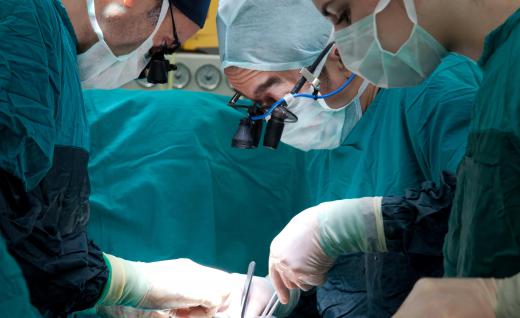What is a Simple Microscope?
 Mary McMahon
Mary McMahon
A simple microscope is a microscope which only has one lens, as opposed to the compound lenses used in more complex microscope designs. Magnifying glasses and loupes are two well-known examples of the simple microscope. This design is classically used for basic microscopes used to introduce children to science and microscopy, and they may be utilized in some industries as well. Jewelers, for example, use loupes to examine specimens for grading and quality determinations.
The basic science behind the simple microscope is quite old, but it was not until the 1600s that the design began to be refined enough for people to actually see objects on a microscopic level. The development of advanced techniques for grinding and shaping lenses allowed professionals such as Hans Janssen and Anton van Leeuwenhoek to develop simple microscopes which advanced the study of biology significantly.

Modern simple microscopes are usually hand held, designed for field work or quick viewing of objects which require magnification. Historical designs included mounts which resemble those used with modern microscopes, although instead of viewing the object through a series of lenses, the user had only one lens to use. The simple microscope also lacks the condensing lens which is used to focus and intensify light for the purpose of achieving better image clarity.

Many science stores sell simple microscopes, sometimes as part of discovery kits for young scientists who want to explore the world around them. It is also possible to order them through microscopy companies and suppliers who handle equipment for jeweling, sewing, and a wide variety of other tasks. Some companies manufacture simple microscopes for specific applications, such as linen testers for the garment industry, or jeweler's loupes which can be worn on the head for ease of use.
The image quality with a simple microscope can be surprisingly good, as researchers learned when they used replications of 17th century simple microscopes to see what exactly it was that biologists found in water supplies in the early days of microscopy. If the lens is of a very high quality and the user knows how to manipulate the microscope to achieve the best focus, contrast, and clarity, the image can be quite excellent, although it is of course impossible to obtain very high levels of magnification with a simple microscope. For basic applications, however, this design can be quite useful, in addition to affordable for people who may not want to shell out for a more advanced microscope design.
AS FEATURED ON:
AS FEATURED ON:












Discussion Comments
The microscope is one of the oldest scientific tools that is still in common use today. It became an indispensable tool in scientific research in the 19th and 20th century. The microscope was invented by Zacharias Janssen, a Dutchman, in 1590, but it was his countryman, Anton van Leeuwenhoek, who got better results with a powerful single-lens magnifier that he himself made.
@Catapult - I’m not sure I would recommend buying a simple microscope for science classrooms, even for middle school. Economically manufactured complex microscopes are relatively cheap and will provide students with a much higher quality experience for studying science.
I think simple microscopes are much better suited to the occupational tasks listed in the article—jeweling, sewing, etc.. When it comes to science, be it for serious research or a middle school education, I think a complex microscope is the guy for the job.
Simple microscopes are also useful in classrooms, particularly for students in middle school or younger. These microscopes are great for simple biology or chemistry observations and experiments. Most simple microscopes are also relatively inexpensive and durable, making them ideal for getting beginning experience using scientific materials.
Post your comments